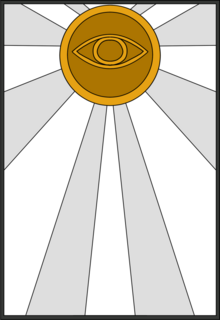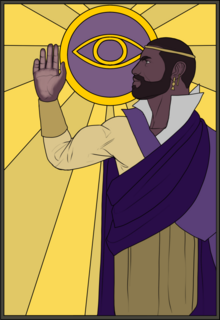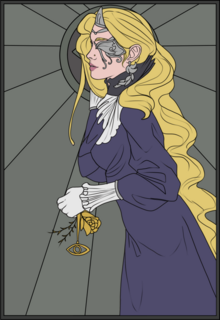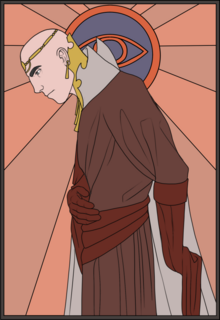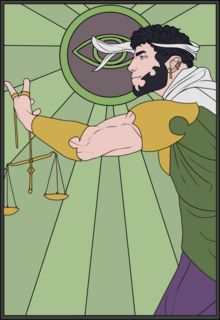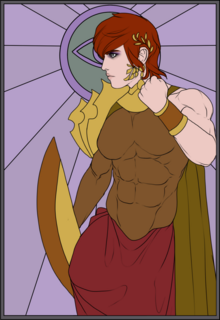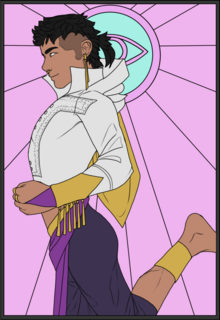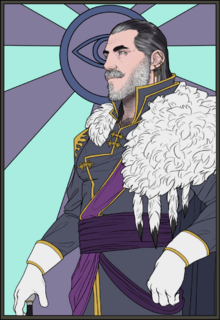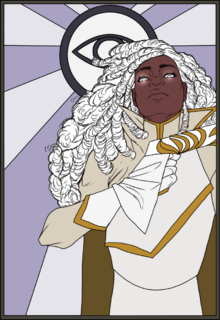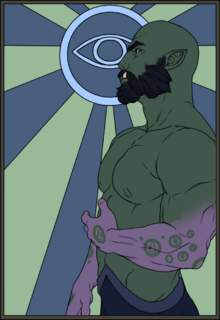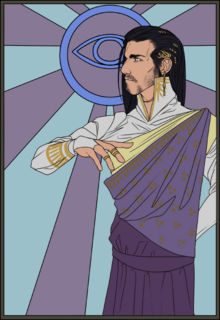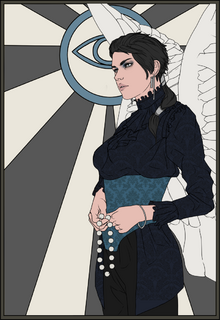More actions
mNo edit summary |
|||
| Line 54: | Line 54: | ||
{| | {| | ||
|[[File:GodTheomar.png|220px|thumb|left]] | |[[File:GodTheomar.png|220px|thumb|left]] | ||
|God Emperor Theomar, | | | ||
*'''Identity:''' God Emperor Theomar, nicknamed the Sun-Father, first Emperor of the Regalian Empire and Prophet of Unionism. | |||
*'''Themes:''' Theomar represents fatherhood, leadership, ambition, devotion and piety. He is remembered for his exceptional charisma and as a loving father who founded an imperial dynasty. | |||
*'''Depictions:''' Theomar is often depicted holding up his hand, with the palm to the viewer. He is always depicted very dignified, and clothed in his royal purple and cream yellow robes, his favorite colors in life. | |||
*'''Worship:''' Worship to Theomar is performed by writing prayers of good health and good fortune for children/employees/followers on pieces of paper and burning them in golden bowls. | |||
*'''Manifestation:''' Theomar has manifested only during very significant events of religious importance, when the continued existence of Unionism hung by a thread, or when the power and influence of the other God Emperors or Empresses would simply not suffice for a task given by the Everwatcher. | |||
*'''Individual:''' Theomar has never appeared to sole individuals, but rather during pivotal moments of the Empire’s history to provide blessings of protection and reinvigorated power. | |||
*'''Worship House:''' Theomar’s main Temple is the Arch Temple of the All-Beacon in Regalia, buried beneath the shrine known as the Dias of Faith. | |||
|} | |||
===Ness, Lady of Forgiveness=== | ===Ness, Lady of Forgiveness=== | ||
{| | {| | ||
|[[File:GoddessNess.png|220px|thumb|left]] | |[[File:GoddessNess.png|220px|thumb|left]] | ||
|God Empress Ness, | | | ||
*'''Identity:''' God Empress Ness, nicknamed the All-Mother, was the wife of Emperor Henri I, Nessaria van Sherburne | |||
*'''Themes:''' Ness represents Forgiveness, Acceptance, Repentance, Absolution, but also the Downtrodden, the Forgotten, the non-Ailor, and the Half-Ailor who feel abandoned. | |||
*'''Depictions:''' Ness is always depicted in her mourning dress with her signature butterfly eye-covers worn after she was blinded for her unfaithfulness to her husband, carrying a golden Unionist Eye chain, along with a golden rose and two sets of rose-thorn stalks. Sometimes her statue has three infants around her pedestal to signify motherhood, and sometimes it has three chained criminals to signify the forgiveness she gave. | |||
*'''Worship:''' Worship to Ness is done by lighting candles in silent vigil, or by seeking priests to find forgiveness for wronging others. | |||
*'''Manifestation:''' Ness frequently manifests to those who believe in Unionism, but need the strongest forgiveness or cannot go on without help to learn to live with their grief, guilt, or torment | |||
*'''Individual:''' Ness appears to individuals relatively often, even seen walking the streets of Regalia seemingly going nowhere. | |||
*'''Worship House:''' Ness's main Temple is the Arch Temple of Salvation in Regalia. She is buried alongside her children: Emperors Bartholomeaux, Carvallais, Maxelle, and Leomar (the former three having been victims of assassination), and Arch-Chancellor Maenarra. | |||
|} | |||
===Juvin, Oracle of Knowledge=== | ===Juvin, Oracle of Knowledge=== | ||
{| | {| | ||
|[[File:GodJuvin.png|220px|thumb|left]] | |[[File:GodJuvin.png|220px|thumb|left]] | ||
|God Emperor Juvin, | | | ||
*'''Identity:''' God Emperor Juvin, nicknamed the All-Knower, was the 11th Emperor of the Regalian Empire, Henri III Ivrae de Sange. | |||
Juvin is often depicted in simple garb with only minimal decorations and dull colors, bowing, kneeling or in some form of submissive stance | *'''Themes:''' Juvin represents piety and virtue, the perfection of learning, and thinkers. | ||
*'''Depictions:''' Juvin is often depicted in simple garb with only minimal decorations and dull colors, bowing, kneeling or in some form of submissive stance. He is depicted tall and frail, with a bald head and a long robe that may sometimes also contain several scrolls and items that intellectuals use to ply their crafts. | |||
*'''Worship:''' Worship to Juvin is done by lighting candles to his will in front of a shrine inside a bookshelf, while incense is lit to absorb the knowledge of the books, in the hopes that Juvin will give the worshipper the means to learn faster. | |||
*'''Manifestation:''' Juvin rarely manifests, but all appearances have been reported in libraries or other places of learning. | |||
*'''Individual:''' Juvin rarely appears to individuals, handing them exactly the one book they were looking for to embark on their journey, while that book was not even in the library to begin with. | |||
*'''Worship House:''' Juvin's main Temple is the Arch Temple of Greater Understanding, where he is buried within the Inner Faith Chamber. | |||
|} | |||
===Almar, Jester of Justice=== | ===Almar, Jester of Justice=== | ||
{| | {| | ||
|[[File:GodAlmar.png|220px|thumb|left]] | |[[File:GodAlmar.png|220px|thumb|left]] | ||
|God Emperor Almar, | | | ||
*'''Identity:''' God Emperor Almar, nicknamed the Blind Jester, was the 13th Emperor of the Regalian Empire, Allamaria Ivrae Heiligenblut (surname different as he was culturally Wirtem). | |||
*'''Themes:''' Almar represents Justice, Law, Honesty, but also of Leisure, Entertainment, Vanity, and Ego. | |||
*'''Depictions:''' Almar is often depicted as a suave and handsome young man, always with either a blindfold or some kind of unraveling cloth disappearing from his eyes. He is also always depicted with a scale that weighs the value of crime and punishment for those who are subject to Almar’s laws. | |||
*'''Worship:''' Worship to Almar is done by writing one's plan or thought on a piece of paper, and weighing it against a golden feather to determine if it is lawful and righteous (lighter) or unlawful and sinful (heavier). | |||
*'''Manifestation:''' Almar is not known to manifest, but the Concilly Council still acknowledges him. | |||
*'''Individual:''' Almar has never appeared to individuals. | |||
*'''Worship House:''' Almar's main Temple is the Arch Temple of Eternal Justice, where the Inner Faith chamber holds his sarcophagus with his favorite scales resting on top that are said to weight the heaviness of a soul as they enter the chamber. | |||
|} | |||
===Allest, Lord of Domination=== | ===Allest, Lord of Domination=== | ||
{| | {| | ||
|[[File:GodAllest.png|220px|thumb|left]] | |[[File:GodAllest.png|220px|thumb|left]] | ||
|God Emperor Allest, | | | ||
*'''Identity:''' God Emperor Allest, nicknamed the Bear-Claw, was the 15th Emperor of the Regalian Empire, Allestrain I Ivrae de Sange. | |||
*'''Themes:''' Allest represents Conquest, Rule, Brotherhood, and Fame. | |||
*'''Depictions:''' Allest is depicted either in his massive bulky armor, or in some state of removal of this armor, in a victorious or intimidating stance. He is depicted tall and glorious with two large claymores, or scabbards holding his favorite swords: Blutkraft and [[Sangria]], weapons that passed into Artifact Legend after his death. | |||
*'''Worship:''' Worship to Allest is done by invoking his name before battle, and by ritually placing a weapon over a cloth soaked in an alcoholic beverage. | |||
*'''Manifestation:''' Allest has manifested after the end of major battles, not to fight, but to mourn the losses on the battlefield with the survivors. | |||
*'''Individual:''' Allest has never appear to the individual, though occasionally those who have lost lovers to the battlefield swear he has appeared in dreams for comfort. | |||
*'''Worship House:''' Allest's main Temple is the Arch Temple of Perpetual Glory, where the Inner Faith Chamber contains his battle armor (as he was killed in battle and his body was never recovered). | |||
|} | |||
===Elia, Mistress of Victory=== | ===Elia, Mistress of Victory=== | ||
{| | {| | ||
|[[File:GoddessElia.png|220px|thumb|left]] | |[[File:GoddessElia.png|220px|thumb|left]] | ||
|God Empress Elia, | | | ||
*'''Identity:''' God Empress Elia, nicknamed the Brass Fist, was the Empress-Consort of Emperor Allestrain I, Eolaria Cadar. | |||
Elia is often depicted with her fist up, sometimes with or without her spiked war-glove, but always with her shield Draackenbuster by her side. She always wears a muscle-fitting bronze armor with a long crimson dress (which she did not wear into battle) complementing her crimson hair. | *'''Themes:''' Elia represents fighting, combat, warfare, victory, love, and loss. | ||
*'''Depictions:''' Elia is often depicted with her fist up, sometimes with or without her spiked war-glove Porcelain-Face, but always with her shield Draackenbuster by her side. She always wears a muscle-fitting bronze armor with a long crimson dress (which she did not wear into battle) complementing her crimson hair. | |||
*'''Worship:''' Worship to Elia is to hold a diary, and to write down secrets and worries and lock it away into the stronghold-lockbox, a religious item that Unionists consider a great sin to steal from. | |||
*'''Manifestation:''' Elia has never manifested, though many claim that she has appeared on select battlefields while the Empire was expanding, leading a divine charge. | |||
*'''Individual:''' Elia has never appeared to individuals, though she left behind several holy Artifacts, most in the Imperial Palace. | |||
*'''Worship House:''' Elia's main Temple is the Arch Temple of Unyielding Perseverance in Regalia, though the sarcophagus next to hers is empty, reserved for Emperor Allestrain I whose body remains missing to this day. | |||
|} | |||
===Vess, Liberator of Chains=== | ===Vess, Liberator of Chains=== | ||
{| | {| | ||
|[[File:Hfhdf.png|220px|thumb|left]] | |[[File:Hfhdf.png|220px|thumb|left]] | ||
|God Emperor Vess, | | | ||
*'''Identity:''' God Emperor Vess, nicknamed the Freedom-Maker, was the 26th Emperor of the Regalian Empire, Vilgemar Ivrae de Sange. | |||
*'''Themes:''' Vess represents happiness, liberty, liberation, freedom, and emancipation. | |||
*'''Depictions:''' Vess is always depicted as a very youthful looking young man, wearing the traditional garb of the palace entertainers, and is always standing in some sort of playful position or pose that elicits some sense of playfulness or youthfulness. | |||
*'''Worship:''' Worship to Vess is done by releasing wishes and prayers into budding flowers, and then placing said flower into a body of water to be released into the world. | |||
*'''Manifestation:''' Vess has rarely manifested, though every time has been to smash the chains of a group of slaves, or freeing them from a burning barn or barrack. | |||
*'''Individual:''' Vess has rarely appeared to enslaved individuals, offering them the keys needed to escape from their chains. | |||
*'''Worship House:''' Vess's main Temple is the Arch Temple of Joyous Everwatch, where the Inner Faith Chamber contains his sarcophagus surrounded by a sea of broken chains, each belong to a slave he helped free. | |||
|} | |||
===Alexander, Mentor of Compromise=== | ===Alexander, Mentor of Compromise=== | ||
{| | {| | ||
|[[File:Alexandro.png|220px|thumb|left]] | |[[File:Alexandro.png|220px|thumb|left]] | ||
| | | | ||
*'''Identity:''' Divine Vessel Alexander is the current Emperor of the Regalian Empire, Alexander Kade Alltmeister. | |||
*'''Themes:''' Emperor Alexander is the Divine Vessel of change, reform, compassion, compromise and mentorship. | |||
*'''Depictions:''' Alexander is depicted in his full imperial regalia, with every government institute and office having a large life-size or greater painting or statue of Him. | |||
*'''Worship:''' As the Vessel, Alexander is not worshipped directly, but rather through service to the Regalian Empire or by praying to the Everwatcher for his health and wellbeing. | |||
*'''Manifestation:''' Alexander is still alive, and is frequently seen when holding Audiences at the Imperial Palace. | |||
*'''Individual:''' As the Emperor, Alexander rarely interacts with individuals outside of public settings, though some nobles and faithful have been able to secure a personal audience with Him. | |||
*'''Worship House:''' Alexander has no official Temples, though one would traditionally see many pilgrims traveling to the Imperial Palace and lighting candles near the front door as an offering of prayer. | |||
|} | |||
===Taal, Mother of Purity=== | ===Taal, Mother of Purity=== | ||
{| | {| | ||
|[[File:Taala.png|220px|thumb|left]] | |[[File:Taala.png|220px|thumb|left]] | ||
|Divine Heroine Taal is a still-living Divine Being | | | ||
*'''Identity:''' Divine Heroine Taal is a still-living Divine Being who is the benefactor of the Belliard Guild. | |||
*'''Themes:''' Taal represents purity, cleanliness, obedience to heritage and hierarchy, tradition, and customs. | |||
*'''Depictions:''' Taal is always depicted in pure-white uniforms with golden trim, wielding a specialized Puretek weapon. | |||
*'''Worship:''' Taal worship is usually not done, though she requires the faithful to be sure of their actions and banish any doubt, and that those wish doubt seek out confessional to rid themselves of what she refers to as “the first door through which evil enters the soul”. Taal also demands the immediate expulsion or termination of any Occult who step out of line, and the cleansing and curing of whatever can be cleansed and cured. | |||
*'''Manifestation:''' Taal is still alive, and is frequently seen in Calemberg and the surrounding regions, but largely avoids coming to Regalia, working closely with the Darkwald Order and other Purist entities in the Empire. | |||
*'''Individual:''' Taal rarely if ever interacts with the individual, though has sometimes appeared to save a would-be victim of Vampire or Cahal attacks. | |||
*'''Worship House:''' Taal has no Temple, as living Heroes cannot have one, though it is assumed that one will be build in Calemberg after her death. | |||
|} | |||
===Borond, Lord of Seas=== | ===Borond, Lord of Seas=== | ||
{| | {| | ||
|[[File:Borond.png|220px|thumb|left]] | |[[File:Borond.png|220px|thumb|left]] | ||
|Divine Hero Borond is | | | ||
*'''Identity:''' Divine Hero Borond is an integrated deity from Asaredu, Buru, whose divinity was recognized by the Concilly Council. | |||
*'''Themes:''' Borond represents the seas, the military, storms and rainfall, and of military ingenuity. | |||
*'''Depictions:''' Borond is depicted as his Eronidas-looking appearance, with the lower body of a shark or dolphin, next to a large gong. | |||
*'''Worship:''' Borond is worshipped by striking a large gong close to the water to ask for his aid in emergency, and by praying for good winds and fair weather. | |||
*'''Manifestation:''' Borond is still alive, and is very active around the Eronidas Pol Cities in Daendroc. | |||
*'''Individual:''' Borond frequently interacts with individuals, even producing children with them. Unionists believe that Borond also reproduces with non-Eronidas, producing Borr-folk, which is rejected by the Asaredu faith. | |||
*'''Worship House:''' Borond does not have a dedicated Temple, though flagships of the Regalian Navy carry a large gong close to the water to call for his aid. | |||
|} | |||
===Nicholas, Architect of Providence=== | |||
===Nicholas, Architect of | |||
{| | {| | ||
|[[File:New Canvasyrdhtrfdtjftuyfgv.png|220px|thumb|left]] | |[[File:New Canvasyrdhtrfdtjftuyfgv.png|220px|thumb|left]] | ||
|Nicholas the | | | ||
*'''Identity:''' Nicholas, nicknamed the Father of Design, was the 14th and longest serving Arch-Chancellor of the Regalian Empire, Klaas. | |||
*'''Themes:''' Nicholas represents leadership, foresight, insight, good planning, longevity, and excellent design. | |||
*'''Depictions:''' Nicholas is always depicted in his Arch-Chancellor robes with his long hair and distinct frail appearance, always in some mid-command or mid-statement pose, as if he is ready to lift or strike out his hand to give the order to unleash whatever machination he has stewed up. | |||
*'''Worship:''' Worship to Nicholas is performed through debate and dialogue, these very acts are considered divine practice, along with self-education and reading books to foster knowledge. | |||
*'''Manifestation:''' Nicholas has never manifested himself, though there are dozens of accounts of people claiming they were drawn into the past to him, where he showed them pivotal moments in history. | |||
*'''Individual:''' Nicholas supposedly grants visions of past events to those in the future who have been lied to, or been fed propaganda to believe an event was different than it actually was. | |||
*'''Worship House:''' Nicholas’s main Temple is the Grand Temple of Imperfect Design in Axenfoort Anglia, which is notable because it was never completed, simply left half-done. | |||
|} | |||
===Elen, Lady of Rivers=== | ===Elen, Lady of Rivers=== | ||
{| | {| | ||
|[[File:Beeboop.png|220px|thumb|left]] | |[[File:Beeboop.png|220px|thumb|left]] | ||
|Elen the Lady of Rivers, is | | | ||
*'''Identity:''' Elen, commonly nicknamed as the Lady of Rivers, is an integrated deity from the old Breizh faith that existed before the Regalian Empire, Ailwen. | |||
Elen is | *'''Themes:''' Elen represents purpose, meaning, destiny, judgement, and burdens. She is specifically considered the patron goddess of Unionist Mages and the Magically tainted, putting her in direct opposition with Taal, Mother of Purity. | ||
*'''Depictions:''' Elen is always depicted with her feather white wings and her beads of prayer, though may also be depicted with her hands raised high holding the Magica Laws, a book of code of conduct. | |||
*'''Worship:''' Elen is prayed to for guidance and purpose by the non-Magically inclined, as well as to be protected from evil Occult, as much as she is worshiped by the Occult to give them a purpose and let their burden (their Magic) find a way to bring glory and benefit to the Empire and the Great Way. | |||
*'''Manifestation:''' Elen does not frequently manifest, though is often seen when the Aelrrigan Order requests that she disable a Renegade's magical connections following a Mage-Trial. | |||
*'''Individual:''' Elen has been known to appear to individuals before those at a pivotal point in life where they feel their purpose is wavering, only for Elen to give them a vision or moral guidance with which to reinvigorate their destiny. | |||
*'''Worship House:''' Elen's Temple is the Temple of Divine Purpose in Kintyr, which is also home to the Unionist Seers, a body of lay-priests who receive visions to help visiting pilgrims with their burdens. | |||
|} | |||
==Priestly Activities== | ==Priestly Activities== | ||
Dogmatic Unionist priests are part of the so-called Dogmatic Religious Community. At the very top is the Concilly Council. Originally this organization had a leader called the Supreme Reverend, however the Supreme Reverend position was abolished when the last Supreme Reverend discovered insidious corruption within the religious community, tried to expose it, and was assassinated for it. To compensate, Conclave determined that the Dogmatic community should henceforth be ruled by a Council of elder Arch-Celates. Below the Concilly Council, are the Arch-Celates, which are equivalents to Dukes in the Regalian Empire. They wield considerable power and rule over vast areas of land, subdivided into Celeries. Below the Arch-Celate is the Celate, or just the average priest. Each Celate administrates a Celerie, which is usually a piece of land donated to the clergy where they maintain temples, shrines, and convents, while also producing crops and tending to cattle. Celates perform all religious tasks such as confession, preaching, hearing concerns, and simply taking care of Unionist needs like a social caretaker or mental health worker. Arch-Celates on the other hand are more administrative in that they take care of the treasury, any military attached to the religious orders, and communication between the Concilly Council and the vast wide-spread Unionist elements. Formally the Emperor is the leader of the Holy Seat, which is more of a group term for the Palace and the Concilly Council grouped together, but historically Emperors have interfered very little in the day to day running of the Celeries, and as such, this fact is usually ignored, the Emperor being considered a completely independent entity. This has also historically separated the Emperor from controversy among the Celates, and vice versa. | Dogmatic Unionist priests are part of the so-called Dogmatic Religious Community. At the very top is the Concilly Council. Originally this organization had a leader called the Supreme Reverend, however the Supreme Reverend position was abolished when the last Supreme Reverend discovered insidious corruption within the religious community, tried to expose it, and was assassinated for it. To compensate, Conclave determined that the Dogmatic community should henceforth be ruled by a Council of elder Arch-Celates. Below the Concilly Council, are the Arch-Celates, which are equivalents to Dukes in the Regalian Empire. They wield considerable power and rule over vast areas of land, subdivided into Celeries. Below the Arch-Celate is the Celate, or just the average priest. Each Celate administrates a Celerie, which is usually a piece of land donated to the clergy where they maintain temples, shrines, and convents, while also producing crops and tending to cattle. Celates perform all religious tasks such as confession, preaching, hearing concerns, and simply taking care of Unionist needs like a social caretaker or mental health worker. Arch-Celates on the other hand are more administrative in that they take care of the treasury, any military attached to the religious orders, and communication between the Concilly Council and the vast wide-spread Unionist elements. Formally the Emperor is the leader of the Holy Seat, which is more of a group term for the Palace and the Concilly Council grouped together, but historically Emperors have interfered very little in the day to day running of the Celeries, and as such, this fact is usually ignored, the Emperor being considered a completely independent entity. This has also historically separated the Emperor from controversy among the Celates, and vice versa. | ||
Revision as of 02:42, 3 August 2022
| Unionism | |
|---|---|
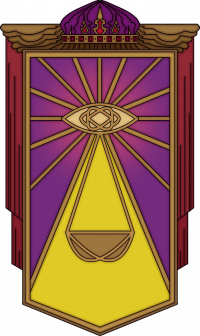 | |
| Religion | |
| Pronunciation | Yoon-yen-is-m |
| Origins | Emperor Theomar |
| Deities | |
| The Everwatcher and various other Gods and Goddesses | |
Origins
The origins of Unionism are well recorded as it is one of the youngest religions in the world. Unionism was originally founded as an Ailor-only religion by the prophet Emperor Theomar I Ivrae-Kade, of the Regalian Empire following its founding. The prophet spoke about a divine entity called the Everwatcher contacting him in a series of visions, before appearing to him in person, to speak to him about the fate of all living things under the stewardship of the Ailor Race. Emperor Theomar then wrote the holy chronicle called the Creed, which acts like holy scriptures, containing all the religious laws and concepts dear to Unionism. Following the prophet’s death, it was ordained that the Everwatcher would select Emperors of Regalia as its Vessel through which it would speak and guide destiny. Each successive Emperor has made small and large changes to Unionist doctrine by editing parts of the Creed, meaning this holy scripture ended up being a document that evolved as time passed. The core concept of an Ailor-dominant world eventually made way for the concept of a Regalia-dominant world, inclusive of all other Races and creating a more acceptable secular basis for the religion. Unionism is fairly unique in comparison to other religions, in that it suffered several schisms, major events of theological conflict between its worshipers that resulted in the community splitting each time. As such, there are 4 distinct Unionist beliefs now: Dogmatic, Evintarian, Emended and Vultragon. Each of these have their own structures, beliefs, and hierarchy, though all invariably worship the Everwatcher, and work towards a common goal, of Regalian hegemony and rule over all the world and its people and for the Emperor of Man to become the Emperor of All.
Schisms
Evintarian Schism
The Evintarian Schism occured directly after the death of the prophet Theomar, when the Concilly Council convened to discuss the matter of the succession. Several Concilly members had dabbled into Magic already, and more of them were of the opinion that Magic could be used to advance Humanity by using it. The hardliner Dogmatic Councillors however felt that Theomar’s preaching on the purity of the soul proved that Magic was a corruption that should be guarded against. The Schism occured when the hardliners broke off the Conclave and started hunting down Magic-users, turning the Empire distinctly anti-Occult. The Evintarian (named after their preacher Horopados Evinter), fled to Etosil and seceded from the Empire. They were later re-integrated into the Empire, but remain religiously separate. And have developed a more pro-Occult and evolution-oriented view of Unionism called Evintarian Unionism. There remains a lot of bad blood between the Evintarian and Dogmatic Unionists because of the religious violence between the two over the centuries.
Emended Schism
The Emended Schism has a somewhat more staggered appearance, in that it did not come about in just a single schism. Originally, Emended Unionism was split between Dogartan Unionism and Vultragon Unionism. Dogartan Unionism was a very small schism of Anglian preachers who rejected the wealth of the Evintarian and Unionist Councils, espousing the virtues of asceticism and poverty. Vultragon Unionism on the other hand was triggered by commoner resentment against the aristocracy and the ruling classes abusing their power, embracing critical thinking as they questioned authority. In recent years, the Dogartan Celates developed new theological arguments heavily rejecting Ivrae-Sange legitimacy and establishing the Emended Divine Beings as their true version of Canon, claiming that the Ivrae dynasty was so incompetent that by their incompetence, they admitted to being usurpers of the true Vessels. This message was well-received by the Vultragons, leading to both communities to merge into the Emended Schism. Because of its inherently critical nature and belief that alexander is not the correct Emperor, Emended Unionism is not well liked by the other religious schisms of Unionism.
Core Identity
Unionism is a religion centered around the tenets of devotion, piety, obedience and ambition, to live by the example of virtuous forebears. Unionism is an organized religion with a centralized priesthood and structure, though each schismatic group is different. Because each group has different core concepts and tenets, each of them will be discussed on a separate page.
Tenets
- Bravery: Unionism requires that all Unionists show bravery in the face of demons, adversity and the natural vices that all living things are born with.
- Calm: Unionism requires that all Unionists remain civil with one another and show kindness even when cruelty and aggression is inflicted on them.
- Chaste: Unionism requires that sexual relations happen only in wedlock, and only in a monogamous sense. Adultery is strictly a sin.
- Ambition: Unionism requires that all Unionists contribute no matter how big or small, to the great dominance of the Regalian Empire.
- Diligence: Unionism requires that those with merit and skill are rewarded and raised to better positions of power to reward their duty to the Empire.
- Forgiving: Unionism requires that all Unionists are forgiving and do not relent to the vices of revenge and pettiness for they are barbaric and banal.
- Charity: Unionism requires that all Unionists create equity for the poorest and weakest, so that even the infirm can contribute through charity and help.
- Honest: Unionism requires honesty and truth, professing the need for a strict but fair law and for fairness for the people both highborn and lowborn.
- Humble: Unionism requires that all Unionists see themselves as no better than the great who came before, and who they will live as an example of.
- Obedience: Unionism requires all Unionists to be obedient to the hierarchy of the state, to the Nobility granted rule from the Emperor, who must not be questioned.
- Great Way: Unionism requires all Unionists to constantly strive to contribute to the Great Way, to find opportunities to further advance the Empire and its people.
- Vessel: Dogmatic Unionists believe that only male Emperors can be the Vessel of the Everwatcher. The succession is Elective however, meaning no-one knows the next heir but the Emperor.
Beliefs
- Narrative: In Unionism all faithful (and even unfaithful) contribute or detrimentally affect something called the Great Way. The Great Way is a promise made by the Everwatcher, that the Regalian Empire now carries the Mantle of Creation, a concept that they must protect life and existence itself from the ruinous powers of corruption and evil. The promise is that one day, if Unionism succeeds, the whole world will be ruled by the Regalian Empire as one state, and all living things will be subject to the Emperor and Vessel of the Everwatcher. When that time comes, the Everwatcher shall unchain the gates of the afterlife where all past Unionists have gone, revive the dead, and bring about a paradise without sickness, death, or sadness. Those who are denied entry into the gates of the afterlife, are instead re-incarnated in the mortal world after their death to try again to prove their soul is worthy.
- Canon Evil: Unionist Canon Evil is somewhat dubious, and exists on multiple levels. The most obvious evil in Unionism is called the Sin of Creation. The Sin of Creation implies that all living beings were born with inherent flaws to overcome to prove their worthiness for the cause of the Great Way. As such, evil is done simply because people do not have self control or inhibitions. The next stage of evil are Demons. Unionism acknowledges all entities coming from different dimensions save the afterlife as Demons seeking to corrupt the minds and wills of the living. These beings infest or seduce the living into giving into their Sin of Creation. The third level of evil is somewhat more ambiguous, as it is other religions. While Unionism doesn’t strictly deny the existence or validity of other religions, it does claim that by worshiping anyone but the Everwatcher, that the living are led astray from creating Paradise, and that they live in sabotage of the Great Way’s conclusion. Essentially, other religions are seen as a distracting evil.
- Identity: The Unionist Creed has no words or thoughts on the matter of gender, sex, sexuality or gender-identity, though the topic of homosexuality is somewhat contentious among Ailor. There is nothing strictly against homosexuality, but a theological argument is made that every Unionist has a duty to sire the next generation of faithful, and to be celibate, same-sex loving, or simply choose not to have children, is seen as a selfish act and one that detrimentally affects the Great Way. As a result, many same-sex Unionists adopt, or find other ways to have children.
- Conversion: Unionism is a religion that has invariably been applied with the sword, or with word, and both interpretations are somewhat correct. Unionists believe that a person, even one who is not Unionist or pretends to be Unionist, can still work towards the Great Way if pointed in the right direction. This is why the Confessions of Melennar are important, because this preacher created a common understanding that as a Regalian Unionist ruler, one’s non-Unionist subjects can still work towards the Empire’s cause, while not believing in the Everwatcher, and their soul can still ascend to the Unionist afterlife if their own religion or a-religiosity will not claim them. As such, conversion by the sword is also fully acceptable, because it forcibly induces someone into the Great Way, though it has become more controversial and less acceptable as of late.
- Sins & Taboo: The worst cases of sinning and taboo for Unionism are blasphemy against the Emperor, hedonism in cruelty (torture, mental abuse, domestic abuse), moral corruption among government and nobles, infanticide, desecrating holy sites, attacking clergy and temples (even of other religions), rejecting the Everwatcher, and being a traitor or saboteur against the Regalian Empire. Unionism does acknowledge confessionals, but Celates can issue a Writ of Sin, a public denunciation and excommunication of a Unionist (or Unionist) to declare them anathema to the religion. It is possible to reverse a Writ of Sin through a Writ of Harmony, but only through some act of self-sacrifice or service to the Emperor.
Gods and Goddesses
Unionism has a concept referred to as Trans-Divinity. Trans-Divinity means that whatever their faith understands to be divine, is fluid and constantly changes based on interpretations. By standard, the Everwatcher is always the indisputably most important entity in Unionism. The Living Emperor is also a living Divine Being who should be worshiped as a god, though it is not illegal to acknowledge his sin of creation flaws from time to time. Below the Emperor and the Everwatcher are the God-Emperors and God-Empresses. When an Emperor or Empress dies, they are no longer divine, as the Vessel passes on to the next heir, but some Emperors or Empresses are raised up in the afterlife by the Everwatcher and sent back to Aloria to guide the people, during which process they are made Divine Beings. Finally, on the lower end of the spectrum are the Heroes of Unionism, which are also considered Divine Beings. Heroes are raised to divinity by the Concilly Council even while they are still alive, and continue to be worshiped after death. This all means that Unionism, as time goes by, gains more and more Gods and Goddesses, while other religions are fairly stagnant. Furthermore, it also means that it’s theoretically possible for other religions to merge into Unionism if their Gods and Goddesses can be proven to be real, and prove their divinity or past divinity. Unionists can combine a variety of Divine Entity worship. By default, all Unionists worship the Everwatcher, however, whoever else is worshiped additionally is up to the individual. Some worshipers choose only a single patron deity, while others choose a collection, or leave just a few out. There are no hard rules to Divine Being worship, in general they exist more as examples to live by, instead of a strict pantheon that demands worship.
The Everwatcher
Theomar, Prophet of All
Ness, Lady of Forgiveness
Juvin, Oracle of Knowledge
Almar, Jester of Justice
Allest, Lord of Domination
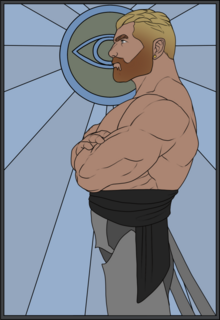 |
|
Elia, Mistress of Victory
Vess, Liberator of Chains
Alexander, Mentor of Compromise
Taal, Mother of Purity
Borond, Lord of Seas
Nicholas, Architect of Providence
Elen, Lady of Rivers
Priestly Activities
Dogmatic Unionist priests are part of the so-called Dogmatic Religious Community. At the very top is the Concilly Council. Originally this organization had a leader called the Supreme Reverend, however the Supreme Reverend position was abolished when the last Supreme Reverend discovered insidious corruption within the religious community, tried to expose it, and was assassinated for it. To compensate, Conclave determined that the Dogmatic community should henceforth be ruled by a Council of elder Arch-Celates. Below the Concilly Council, are the Arch-Celates, which are equivalents to Dukes in the Regalian Empire. They wield considerable power and rule over vast areas of land, subdivided into Celeries. Below the Arch-Celate is the Celate, or just the average priest. Each Celate administrates a Celerie, which is usually a piece of land donated to the clergy where they maintain temples, shrines, and convents, while also producing crops and tending to cattle. Celates perform all religious tasks such as confession, preaching, hearing concerns, and simply taking care of Unionist needs like a social caretaker or mental health worker. Arch-Celates on the other hand are more administrative in that they take care of the treasury, any military attached to the religious orders, and communication between the Concilly Council and the vast wide-spread Unionist elements. Formally the Emperor is the leader of the Holy Seat, which is more of a group term for the Palace and the Concilly Council grouped together, but historically Emperors have interfered very little in the day to day running of the Celeries, and as such, this fact is usually ignored, the Emperor being considered a completely independent entity. This has also historically separated the Emperor from controversy among the Celates, and vice versa.
Trivia
- The matter of depicting the God Emperors or God Empresses is controversial at best. Many priests believe that mortals are fallible and cannot depict the Gods and Goddesses in an accurate or divine manner. Any art produced of the Gods or Goddesses is extremely scrutinized. More curiously yet, the eyes of all depictions of the Gods or Goddesses are always depicted in white. This is because the iris colors of the Emperors or Empresses is always a matter of intense debate and historical revision.
- Unionism used to be mandatory for nobility somewhere during the second century after Cataclysm, though this Holy Law was removed when the war against the Skagger Horde ceased, and the Empire benefited more from including non-Unionists into the peerage. An exception had always been made for the Altalar nobles of Solvaan origins in Solleria however, called the Confessions of Melennar.
- Sectarian violence largely came to an end at the turn into the fourth century as the last attacks on Vultragon Unionist by state forces ceased, and an uneasy truce was signed between the Schism religious communities. They still do not see eye-to-eye, and the different Schismatic groups still prod at each other, but instead of murdering each other over sectarian differences, they mostly fight with words nowadays, a legacy of the Kleine Rechnung, the document that called for the truce.
- Despite Elen's absorption into Unionism, the Breizh still maintained a high level of cultural autonomy, some even clinging to old beliefs. As such, even when Magic became illegal in the Empire, the Breizh Aelrrigan Order continued to find and train Mages safely in their sanctuaries while the rest of the Empire turned to brutal oppression (and the Magic part of Elen was surpressed from dogma). Elen's faithful among the Aelrrigan Order are commonly cited as the reason why Magic acceptance eventually returned, and Elen's magical nature in theological teachings was returned.
| ||||||||||
| Accreditation | |||||||
|---|---|---|---|---|---|---|---|
|
| ||||||
